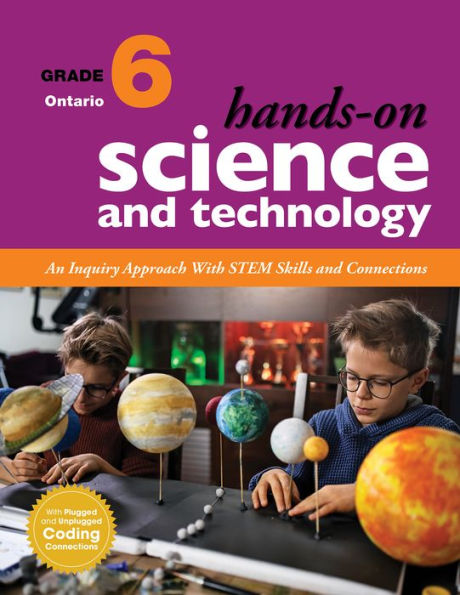- STEM Skills and Connections
- Life Systems: Biodiversity
- Matter and Energy: Electricity and Electrical Devices
- Structures and Mechanisms: Flight
- Earth and Space Systems: Space
Hands-On Science and Technology for Ontario, Grade 6 encourages students’ natural curiosity about science and the world around them as they participate in hands-on activities and explore their environment. Using the inquiry approach, this comprehensive resource
- fosters students’ understanding of STEM (science, technology, engineering, and mathematics) skills
- makes coding and emerging technologies approachable for both teachers and students
- emphasizes personalized learning using a four-part instructional process: activate, action, consolidate and debrief, enhance
- relates science and technology to sustainability and our changing world, including society, the economy, and the environment
- focuses on practical applications of the engineering design process as students work on solutions to real-life problems
- builds understanding of Indigenous knowledge and perspectives specific to Ontario
- explores contributions to science and technology by people with diverse lived experiences
Using proven Hands-On features, this book provides resources for both teachers and students including background information on the science topics; complete, easy-to-follow lesson plans; materials lists; and digital image banks and reproducibles (find download instructions in the Appendix of the book).
Innovative elements developed specifically for the Ontario curriculum include the following:
- plugged and unplugged coding activities in nearly every lesson
- land-based learning activities
- opportunities for students to use guided research, hands-on inquiry, and the engineering design process
- a fully developed assessment plan to guide assessment for, as, and of learning
- ideas and prompts for STEM Makerspace projects
- STEM Skills and Connections
- Life Systems: Biodiversity
- Matter and Energy: Electricity and Electrical Devices
- Structures and Mechanisms: Flight
- Earth and Space Systems: Space
Hands-On Science and Technology for Ontario, Grade 6 encourages students’ natural curiosity about science and the world around them as they participate in hands-on activities and explore their environment. Using the inquiry approach, this comprehensive resource
- fosters students’ understanding of STEM (science, technology, engineering, and mathematics) skills
- makes coding and emerging technologies approachable for both teachers and students
- emphasizes personalized learning using a four-part instructional process: activate, action, consolidate and debrief, enhance
- relates science and technology to sustainability and our changing world, including society, the economy, and the environment
- focuses on practical applications of the engineering design process as students work on solutions to real-life problems
- builds understanding of Indigenous knowledge and perspectives specific to Ontario
- explores contributions to science and technology by people with diverse lived experiences
Using proven Hands-On features, this book provides resources for both teachers and students including background information on the science topics; complete, easy-to-follow lesson plans; materials lists; and digital image banks and reproducibles (find download instructions in the Appendix of the book).
Innovative elements developed specifically for the Ontario curriculum include the following:
- plugged and unplugged coding activities in nearly every lesson
- land-based learning activities
- opportunities for students to use guided research, hands-on inquiry, and the engineering design process
- a fully developed assessment plan to guide assessment for, as, and of learning
- ideas and prompts for STEM Makerspace projects

Hands-On Science and Technology for Ontario, Grade 6: An Inquiry Approach With STEM Skills and Connections
359
Hands-On Science and Technology for Ontario, Grade 6: An Inquiry Approach With STEM Skills and Connections
359(Spiral Bound - New Edition, Updated & Revised)

Product Details
| ISBN-13: | 9781774920718 |
|---|---|
| Publisher: | Portage & Main Press |
| Publication date: | 03/17/2026 |
| Series: | Hands-On Science and Technology for Ontario |
| Edition description: | New Edition, Updated & Revised |
| Pages: | 359 |
| Product dimensions: | 8.50(w) x 11.00(h) x 1.50(d) |
